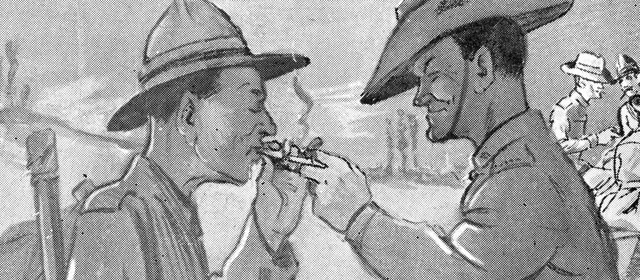Story summary
The first New Zealand smokers
Smoking arrived in New Zealand with the earliest Europeans. Māori soon adopted the habit and began growing tobacco.
Most smokers used pipes. Cigars were for the wealthy, and cigarettes, which had to be hand-rolled, were rare. Māori men and women both smoked, but few European women did.
Consumption of tobacco rose fast in New Zealand in the 1860s – almost all gold miners smoked, as did many European soldiers in the New Zealand wars.
Many middle-class men appreciated the pipe not only as a relaxing pastime but as an expression of individuality. A pipe smoker might have favourite tobaccos, a selection of stylish pipes and perhaps even a smoking jacket and cap.
The rise of the cigarette
From 1839 a new curing process produced milder tobacco able to be more comfortably inhaled. From the 1880s tailor-made cigarettes grew cheaper as their production was mechanised. In New Zealand they increased in popularity gradually.
Local cigarette companies emerged, and for a time there was a requirement that they use 30–40% locally grown tobacco leaf.
European women in New Zealand took up cigarette smoking in the early 20th century, and smoking rates amongst both men and women rose steadily, encouraged by the two world wars. Soldiers found cigarettes comforting, and women who entered the workforce while men were at war had their own income and wanted to escape anxiety.
By the 1950s almost three-quarters of New Zealand men and a third of women smoked.
Health worries
Opposition to smoking began early. The Anti-Nicotine Society, founded in 1883, believed that smoking led to other vices such as drunkenness. Others worried about the fire risk posed by smoking in a country full of wooden buildings.
The first New Zealand Health Department warning against smoking appeared in 1945. By the 1950s signs of increasing lung cancer rates were emerging. In 1964 the US Surgeon General’s report linked smoking to lung cancer, heart disease and other medical problems.
By the late 1980s about 5,000 New Zealanders were dying each year from smoking-related illnesses – about one in five of all adult deaths.
The New Zealand government introduced a range of measures including age restrictions on sales, higher taxes on tobacco products, restrictions on cigarette advertising and sponsorship, warnings on cigarette packets, the creation of smokefree areas, and assistance towards quitting.
Changing times
The late 1980s saw a significant change. Between 1984 and 1992 the number of cigarettes smoked per adult fell by over 40%.
In the first decade of the 21st century consumption fell again. However, the decline varied in different parts of society. Smoking rates were highest among Māori and Polynesians, people on low incomes, those who were less-educated, and increasingly, among women.





